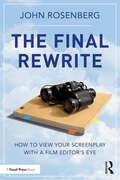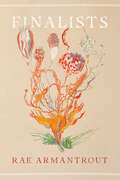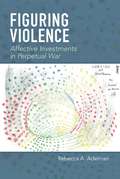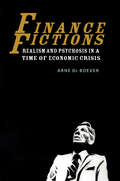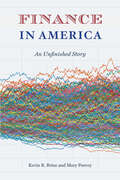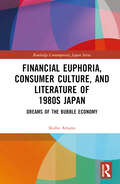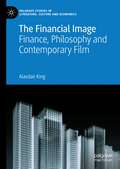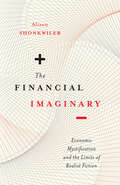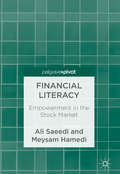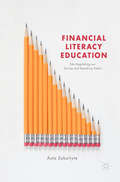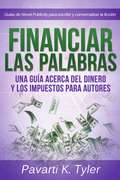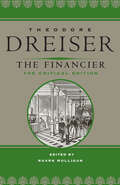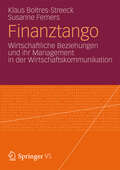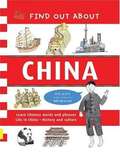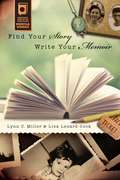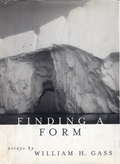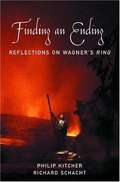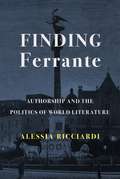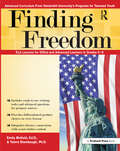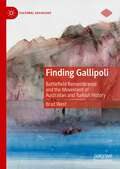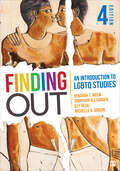- Table View
- List View
The Final Rewrite: How to View Your Screenplay with a Film Editor’s Eye
by John RosenbergThis book offers a unique perspective on crafting your screenplay from an editor’s point-of-view. Special features include before and after examples from preproduction scripts to post production final cuts, giving screenwriters an opportunity to understand how their screenplay is visualized in post production. By the time a script reaches the editing room, it has passed through many hands and undergone many changes. The producer, production designer, director, cinematographer, and actor have all influenced the process before it gets to the editor’s hands. Few scripts can withstand the careful scrutiny of the editing room. This book reveals how to develop a script that will retain its original vision and intent under the harsh light of the editing console. It provides insights that writers (as well as producers and directors) need and editors can provide for a safe journey from the printed page to the final release. This book is ideal for aspiring and early career screenwriters, as well as filmmakers and established screenwriters who want to gain a better understanding of the editing process.
Finalists (Wesleyan Poetry Ser.)
by Rae ArmantroutA double book by Pulitzer Prize winning poet Rae Armantrout What will we call the last generation before the looming end times? With Finalists Rae Armantrout suggests one option. Brilliant and irascible, playful and intense, Armantrout nails the current moment's debris fields and super computers, its sizzling malaise and confusion, with an exemplary immensity of heart and a boundless capacity for humor. The poems in this book find (and create) beauty in midst of the ongoing crisis. CONTRAST What's to like if not contrast? Shadows beneath the model's sharp cheekbones, her ample yet precise lips. Clean lines separating bounty from its opposite. This is not what I want to want. These eyes on the hypothetical distance.
Finally Comes the Poet: Daring Speech for Proclamation
by Walter BrueggemannFour lectures on preaching as a subversive activity, in which scripture, preacher and community are brought together to "voice a new world".
Finance Fictions: Affective Investments in Perpetual War
by Rebecca A. AdelmanIn the United States, the early years of the war on terror were marked by the primacy of affects like fear and insecurity. These aligned neatly with the state’s drive toward intensive securitization and an aggressive foreign policy. But for the broader citizenry, such affects were tolerable at best and unbearable at worst; they were not sustainable. Figuring Violence catalogs the affects that define the latter stages of this war and the imaginative work that underpins them. These affects—apprehension, affection, admiration, gratitude, pity, and righteous anger—are far more subtle and durable than their predecessors, rendering them deeply compatible with the ambitions of a state embroiling itself in a perpetual and unwinnable war.Surveying the cultural landscape of this sprawling conflict, Figuring Violence reveals the varied mechanisms by which these affects have been militarized. Rebecca Adelman tracks their convergences around six types of beings: civilian children, military children, military spouses, veterans with PTSD and TBI, Guantánamo detainees, and military dogs. All of these groups have become preferred objects of sentiment in wartime public culture, but they also have in common their status as political subjects who are partially or fully unknowable. They become visible to outsiders through a range of mediated and imaginative practices that are ostensibly motivated by concern or compassion. However, these practices actually function to reduce these beings to abstracted figures, silencing their political subjectivities and obscuring their suffering. As a result, they are erased and rendered hypervisible at once. Figuring Violence demonstrates that this dynamic ultimately propagates the very militarism that begets their victimization.
Finance Fictions: Realism and Psychosis in a Time of Economic Crisis
by Arne De BoeverBuilding on both established and emerging discussions of literature and finance, Finance Fictions takes the measure of the tension between psychosis and realism in the contemporary finance novel. Revisiting such twentieth-century classics of the genre as Tom Wolfe's Bonfire of the Vanities and Bret Easton Ellis’s American Psycho, this book considers that the twenty-first century is witnessing the birth of a new kind of finance novel that in the face of an ongoing economic crisis, ever more frequent market crashes, and the politics of austerity, pursues a more realist approach to the actual workings of the economy. But what kind of realism would be attuned to today’s economic reality of high-frequency trading, dominated by complex financial instruments like collateralized debt obligations and credit default swaps, and digital algorithms operating at speeds faster than what human beings or computers can record? If Tom Wolfe in 1989 could still urge novelists to work harder to “tame the billion-footed beast of reality”, it seems today’s economic reality confronts us with a difference that is qualitative rather than quantitative: a new financial ontology requiring new modes of thinking and writing. Mobilizing the philosophical thought of Quentin Meillassoux in the close-reading of finance novels by Robert Harris, Michel Houellebecq, Ben Lerner and less well-known works of conceptual writing such as Mathew Timmons’ Credit, Finance Fictions argues that realism is in for a speculative update if it wants to take on the contemporary economy—an “if” whose implications turn out to be deeply political. Part literary study and part philosophical inquiry, Finance Fictions seeks to contribute to a new mindset for creative and critical work on finance in the twenty-first century.
Finance in America: An Unfinished Story
by Kevin R. Brine Mary PooveyThe economic crisis of 2008 led to an unprecedented focus on the world of high finance—and revealed it to be far more arcane and influential than most people could ever have imagined. Any hope of avoiding future crises, it’s clear, rest on understanding finance itself. To understand finance, however, we have to learn its history, and this book fills that need. Kevin R. Brine, an industry veteran, and Mary Poovey, an acclaimed historian, show that finance as we know it today emerged gradually in the late nineteenth century and only coalesced after World War II, becoming ever more complicated—and ever more central to the American economy. The authors explain the models, regulations, and institutions at the heart of modern finance and uncover the complex and sometimes surprising origins of its critical features, such as corporate accounting standards, the Federal Reserve System, risk management practices, and American Keynesian and New Classic monetary economics. This book sees finance through its highs and lows, from pre-Depression to post-Recession, exploring the myriad ways in which the practices of finance and the realities of the economy influenced one another through the years. A masterwork of collaboration, Finance in America lays bare the theories and practices that constitute finance, opening up the discussion of its role and risks to a broad range of scholars and citizens.
Financial Euphoria, Consumer Culture, and Literature of 1980s Japan: Dreams of the Bubble Economy (Routledge Contemporary Japan Series)
by Ikuho AmanoThis book is an interdisciplinary study of Japan during the socially euphoric years of the Bubble Economy in the 1980s. Shedding light on consumer experiences, this study explores the socio-cultural landscape of Japan, the nation that boasted the second largest economy in the late twentieth century. Drawing its analysis from various media sources, popular literary works, and public reports, the book articulates how the late 1980s calibrated consumer demands, lifestyles, and perceptions of wealth. Through an examination of the qualitative effects of ‘Bubble money’ on consumers, the book disentangles the anatomy of the festive ambience in the economic phase, closely reading fictional and non-fictional literary works that play the role of reportage, critique, and satire. Through observations of human behaviours in consumption, the book reveals psychosomatic experiences and self-consciousness. Featuring a wide range of sources from Japanese media and literary works which have yet to be translated for an English audience, this book will be a valuable resource for students and scholars of modern Japanese culture and literature who are interested in the socio-economic landscape of late-twentieth-century Japan.
The Financial Image: Finance, Philosophy and Contemporary Film (Palgrave Studies in Literature, Culture and Economics)
by Alasdair KingThe Financial Image: Finance, Philosophy, and Contemporary Film draws on a broad range of narrative feature films, documentaries, and moving image installations in the US, Europe, and Asia. Using frameworks from contemporary philosophy and critical finance studies, the book explores how contemporary cinema has registered recent financial and economic issues. The book focuses on how filmmakers have found formal means to explore, celebrate, and critique the increasingly important role that the financial sector plays in shaping global economic, political, ethical, and social life.
The Financial Imaginary: Economic Mystification and the Limits of Realist Fiction
by Alison ShonkwilerAs the world has been reshaped since the 1970s by neoliberalism and globalization, increasing financial abstraction has presented a new political urgency for contemporary writers. Globalized finance, the return to Gilded Age levels of inequality, and the emergence of new technologies pose a similar challenge to the one faced by American social realists a century ago: making the virtualization of capitalism legible within the conventions of the realist novel. In The Financial Imaginary, Alison Shonkwiler reads texts by Richard Powers, Don DeLillo, Jane Smiley, Teddy Wayne, and Mohsin Hamid to examine how fiction confronts the formal and representational mystifications of the economic. As Shonkwiler shows, these contemporary writers navigate the social, moral, and class preoccupations of American &“economic fiction&” (as shaped by such writers as William Dean Howells, Henry James, Frank Norris, and Theodore Dreiser), even as they probe the novel&’s inadequacies to tell the story of an increasingly abstract world system. Drawing a connection from historical and theoretical accounts of financialization to the formal contours of contemporary fiction, The Financial Imaginary examines the persistent yet vexed relationship between financial representation and the demands of literary realism. It argues that the novel is essential to understanding our relation to the mystifications of abstraction past and present.
Financial Literacy: Empowerment In The Stock Market
by Meysam Hamedi Ali SaeediThis book provides an overview of current issues associated to financial literacy improvement. In selecting and structuring the material to include, the primary criterion has been applicability of topics and recommendations and accuracy of trends toward better financial literacy level. Each chapter is dedicated to a particular component of financial literacy from education to capability.Throughout the book, there are many practices initiated around the world which, regardless of their superiority, are all useful initiatives and can roll play as a spot light in the road of improvement for both investors and authorities. This book is not only applicable for academics and students, but authorities who aim to improve financial literacy (and subsequently financial capability) among individuals and for those investors who seek to improve their own financial literacy.
Financial Literacy Education
by Asta ZokaityteThis book explores the issue of consumer financial education, responding to increased interest in, and calls to improve peoples' financial literacy skills and abilities to understand and manage their money. New conceptual frameworks introduced in the book offer academic audiences an innovative way of thinking about the project on financial literacy education. Using the concepts of 'edu-regulation' and 'financial knowledge democratisation' to analyse the financial education project in the UK, the book exposes serious, and often ignored, limitations to using information and education as tools for consumer protection. It challenges the mainstream representation of financial literacy education as a viable solution to consumer financial exclusion and poverty. Instead, it argues that the project on financial literacy education fails to acknowledge important dependences between consumer financial behaviour and the socio-economic, political, and cultural context within which consumers live. Finally, it reveals how these international and national calls for ever greater financial education oversimplify and underestimate the complexity of consumer financial decision-making in our modern times.
Financiar las palabras: Una guía acerca del dinero y los impuestos para autores
by Pavarti K. Tyler Alma Edith GarciaOrganizar tus finanzas personales significa ganar más dinero y ¿quién no quiere ganar más dinero? Los escritores tienden a ser personas con facilidad para las palabras, ¡lo que significa que la temporada de pago de impuestos puede causarles mucha angustia! ¿Has estado tomando todas las medidas necesarias para asegurarte de que puedas maximizar tu devolución? ¿Estás guardando todos tus recibos en una caja de zapatos? ¿Tienes pesadillas llenas de signos de dólares flotando en el aire y mientras te preocupas por todo el dinero que vas a deber después de que por fin termines de declarar impuestos? ¡ Financiar las palabras está aquí para ayudarte! Prepárate para aprender todo lo que jamás hayas necesitado aprender sobre operar tu propio negocio y declarar impuestos como autor y a dedicar tan sólo unas horas a preparar tus registros. Con Pavarti K. Tyler como tu guía, harás un recorrido por los números, aprenderás cuáles gastos son deducibles y cuáles no, te enterarás de trucos para preparar tu empresa como autor y recibirás recomendaciones innovadoras para aplicar tu talento y agregar un poco más de grosor a tu alcancía. Con este guía, recibirás explicaciones prácticas y fáciles de entender acerca de cómo organizar y como administrar tus finanzas, incluyendo: Cómo ser un emprendedor exitoso La regla de impuestos #1 que tienes que saber Ganar dinero y qué hacer con él Los pros y contras de establecer una sociedad Los pagos a diseñadores, editores y otros contratistas Preguntas frecuentes Maximizar tus deducciones Determinar cuáles son tus bienes o activos Ganar dinero por gastar dinero Contratar a un profesional de impuestos o presentar tu declaración tú mismo ¡También ofrecemos nueve regalos exclusivos para los lectores de este libro! Nuestra garantía: ¿Estás cansado de examinar meticulosamente las guías de marketing que se centran más en la experienc
The Financier: The Critical Edition (The Dreiser Edition)
by Theodore DreiserFirst published in 1912, Theodore Dreiser's third novel, The Financier, captures the ruthlessness and sparkle of the Gilded Age alongside the charismatic amorality of the power brokers and bankers of the mid-nineteenth century. This volume is the first modern edition of The Financier to draw on the uncorrected page proofs of the original 1912 version, which established Dreiser as a master of the American business novel. The novel was the first volume of Dreiser’s Trilogy of Desire, also known as the Cowperwood Trilogy, which includes The Titan (1914) and The Stoic (1947). Dreiser laboriously researched the business practices and personal exploits of real-life robber baron Charles Yerkes to narrate Frank Algernon Cowperwood's early career in The Financier, which explores the unscrupulous world of finance from the Civil War through the panic incited by the 1871 Chicago fire. In 1927, the monumental novel reappeared in a radically revised version for which Dreiser, notorious for lengthy novels, agreed to cut more than two hundred and seventy pages. This revised version became the most familiar, reprinted by publishers and studied by scholars for decades. For this new edition, Roark Mulligan meticulously reviewed earlier versions of the novel and its publication history, including the last-minute removal of paragraphs, pages, and even whole chapters from the 1912 edition, cuts based mainly on the advice of H. L. Mencken. The restored text better matches Dreiser's original vision for the work. More than three hundred additional pages not available to modern readers--including those cut from the 1927 edition and more than seventy hastily removed from the manuscript just days before publication in 1912--more effectively establish characterization and motivation. Restored passages dedicated to the internal thoughts of major and minor characters bring a softer dimension to a novel primarily celebrated for its realistic attention to the cold external world of finance. Mulligan's historical commentary reveals new insights into Dreiser's creative practices and how his business knowledge shaped The Financier. This supplemental material considers the novel's place within the tradition of American business novels and its reflections on the scandalous business practices of the robber baron era.
Finanztango
by Klaus Boltres-Streeck Susanne FemersWirtschaftskommunikation ist eine vielfältige Managementaufgabe. Gegenstände der Steuerung sind zweifelsohne die Inhalte und Instrumente der Kommunikation. Management in der Wirtschaftskommunikation bedeutet aber mehr: Vielfältige Beziehungen der Akteure im Kommunikationsprozess sind von Kommunikationsmanagern aktiv und bewusst zu gestalten. Im "Finanztango" dieser Wirtschaftsbeziehungen sind daher für zielorientierte Kommunikation die Parkettbeschaffenheit zu prüfen, die gemeinsamen Schrittfolgen genau zu planen und mögliche Hindernisse abzuschätzen. Dieses Buch bündelt und systematisiert Wissen zum Beziehungsmanagement, damit die Pflicht nicht zur Bürde und die Kür ohne Abzug in der B-Note absolviert wird .
Find Out About China: Learn Chinese Words And Phrases And About Life In China (Find Out About Books)
by Zheng Qing Tim HutchinsonEach Find Out About book introduces boys and girls to a different country, its people, its history, its culture, and its language. The books are divided into four parts:
Find Your Story, Write Your Memoir
by Lynn C. Miller Lisa Lenard-CookEvery person has a story to tell, but few beginners know how to uncover their story's narrative potential. And despite a growing interest among students and creative writers, few guides to the genre of memoirs and creative nonfiction highlight compelling storytelling strategies. Addressing this gap, authors Lynn C. Miller and Lisa Lenard-Cook provide a compact, accessible guide to memoir writing that shows how an aspiring memoir writer can use storytelling tools and tactics borrowed from fiction to weave personal experiences into the shape of a story. Find Your Story, Write Your Memoiroffers an overview of the building blocks of memoir writing. Individual chapters focus on key issues and challenges, such as the balance between the remembering narrator and the experiencing narrator, the capacity to honor the subjective voice, the occasion of telling (why does this narrator tell this storynow?), creating an organically functional structure for a particular story, and taking the next steps with a written memoir. Drawing on their combined years of experience teaching memoir writing, authoring works of fiction and nonfiction, and working in autobiographical performance, Miller and Lenard-Cook provide a practical guide whose core philosophy is motivated by a key word:story.
Find Your Way (Reach Into Phonics Ser.)
by Chris Medrick John Grigsby Deborah J. ShortNIMAC-sourced textbook
Finding a Form
by William H. GassFrom the author of The Tunnel comes a new collection of essays, his first in eight years, on art, writing, nature and culture. This book is by one of the most important and briliant thinkers at work today.
Finding an Ending: Reflections on Wagner's Ring
by Philip Kitcher Richard SchachtFew musical works loom as large in Western culture as Richard Wagner's four-partRing of the Nibelung. InFinding an Ending, two eminent philosophers, Philip Kitcher and Richard Schacht, offer an illuminating look at this greatest of Wagner's achievements, focusing on its far-reaching and subtle exploration of problems of meanings and endings in this life and world. Kitcher and Schacht plunge the reader into the heart of Wagner'sRing, drawing out the philosophical and human significance of the text and the music. They show how different forms of love, freedom, heroism, authority, and judgment are explored and tested as it unfolds. As they journey across its sweeping musical-dramatic landscape, Kitcher and Schacht lead us to the central concern of the Ring--the problem of endowing life with genuine significance that can be enhanced rather than negated by its ending, if the right sort of ending can be found. The drama originates in Wotan's quest for a transformation of the primordial state of things into a world in which life can be lived more meaningfully. The authors trace the evolution of Wotan's efforts, the intricate problems he confronts, and his failures and defeats. But while the problem Wotan poses for himself proves to be insoluble as he conceives of it, they suggest that his very efforts and failures set the stage for the transformation of his problem, and for the only sort of resolution of it that may be humanly possible--to which it is not Siegfried but rather Br nnhilde who shows the way. TheRing's ending, with its passing of the gods above and destruction of the world below, might seem to be devastating; but Kitcher and Schacht see a kind of meaning in and through the ending revealed to us that is profoundly affirmative, and that has perhaps never been so powerfully and so beautifully expressed. At the end of the book is a very detailed synopsis of all four operas.
Finding Ferrante: Authorship and the Politics of World Literature
by Alessia RicciardiElena Ferrante’s Neapolitan novels achieved stunning global success in part because of the mystery surrounding their pseudonymous author. English-speaking readers were tantalized by her enigmatic biography as well as what they took to be her authentic portrayal of working-class Naples. However, we now know that the person behind the writing is most likely Anita Raja, a prominent translator of German literature whose background is very different from Ferrante’s supposed life.In Finding Ferrante, Alessia Ricciardi revisits questions about Ferrante’s identity to show how the problem of authorship is deeply intertwined with the novels’ literary ambition and politics. Going beyond the local and national cultures of Naples and Italy, Ricciardi reads Ferrante’s fiction as world literature, foregrounding Raja’s work as a translator. She examines the novels’ engagement with German literature and criticism, particularly Goethe, Walter Benjamin, and Christa Wolf, while also tracing the influence of Italian thinkers such as Antonio Gramsci, Carla Lonzi, and the Milan Women’s Bookstore Collective. Considering central questions of sexuality, work, politics, and place, Ricciardi demonstrates how intertextual resonances reshape our understanding of Lila and Elena, the protagonists of the Neapolitan Quartet, as well as the characters and language of Ferrante’s other books.This bold reconsideration of one of today’s most acclaimed authors reveals Ferrante’s works as fiercely intellectual, showing their deep concern with feminist and cultural politics and the ethical and political stakes of literature.
Finding Freedom: ELA Lessons for Gifted and Advanced Learners in Grades 6-8
by Emily Mofield Tamra StambaughFinding Freedom invites students to follow America's journey toward finding freedom by examining multiple perspectives, conflicts, ideas, and challenges through seminal historical texts. This unit, developed by Vanderbilt University's Programs for Talented Youth and aligned to the Common Core State Standards (CCSS), features close readings of some of the most famous American political speeches from notable Americans, presidents, and minority voices. To sharpen historical thinking, students analyze arguments for freedom, examine dissenting perspectives, and reason through multiple viewpoints of historical issues through debates and interactive activities. To develop advanced literacy skills, students evaluate effective rhetorical appeals, claims, supporting evidence, and techniques that advance arguments. Students synthesize their learning by comparing speeches to each other, relating texts to contemporary issues of today, and making interdisciplinary connections. Lessons include close readings with text-dependent questions, choice-based differentiated products, rubrics, formative assessments, social studies content connections, and ELA tasks that require argument and explanatory writing. Ideal for pre-AP and honors courses, the unit features speeches from Patrick Henry, Frederick Douglass, Carrie Chapman Catt, and Presidents Franklin D. Roosevelt, Lincoln, Kennedy, Johnson, George W. Bush, Obama, and others. Grades 6-8
Finding Gallipoli: Battlefield Remembrance and the Movement of Australian and Turkish History (Cultural Sociology)
by Brad WestThis book is about how Australian and Turkish historical understanding of the First World War Gallipoli Campaign has been shaped by travel to the battlefield for the purposes of commemoration. Utilizing a cultural historical method, the study begins with examining how cultural conceptions of travel influenced the experience of those fighting in the 1915 Battle, and ends with the way that new global insecurities and the withdrawal of Western troops from Afghanistan in 2021 is reflecting and influencing Australia and Turkey’s social memory of their military past. This wide historical lens and the author’s original fieldwork and analysis of documents allows for an in-depth exploration of the ways in which cultural patterns of social memory develop over time and mapping of how specific cultural representations in the past are reclaimed. The book argues that travel is a key factor influencing social change by providing distinctive ritual experiences that afford unique, discursive opportunities and empowering particular carriers and custodians of social memory.
Finding Nothing: The VanGardes, 1959-1975
by Gregory BettsExperimental literature accelerated dramatically in Vancouver in the 1960s as the influence of New American poetics merged with the ideas of Marshall McLuhan. Vancouver poets and artists began thinking about their creative works with new clarity and set about testing and redefining the boundaries of literature. As new gardes in Vancouver explored the limits of text and language, some writers began incorporating collage and concrete poetics into their work while others delved deeper into unsettling, revolutionary, and Surrealist imagery. There was a presumption across the avant-garde communities that radical openness could provoke widespread socio-political change. In other words, the intermedia experimentation and the related destruction of the line between art and society pushed art to the frontlines of a broad socio-political battle of the collective imagination of Vancouver. Finding Nothing traces the rise of the radical avant-garde in Vancouver, from the initial salvos of the Tish group, through Blewointment’s spatial experiments, to radical Surrealisms and new feminisms. Incorporating images, original texts, and interviews, Gregory Betts shows how the VanGardes signalled a remarkable consciousness of the globalized forces at play in the city, impacting communities, orientations, races, and nations.
Finding Out: An Introduction to LGBTQ Studies
by Deborah T. Meem Michelle A. Gibson Jonathan F. Alexander Key BeckFinding Out, Fourth Edition introduces readers to lesbian-gay-bisexual-transgender-queer (LGBTQ) studies. By combining accessible introductory and explanatory material with primary texts and artifacts, this text/reader explores the development and growth of LGBTQ identities and the interdisciplinary nature of sexuality studies. Now available in a digital ebook format, the fourth edition has been thoroughly updated to include a new chapter on "Trans Lives and Theories", and new readings. Chapters include more discussions of important and current issues in LGBTQ studies such as the emergence of non-binary identities, and issues of race and class, making Finding Out, Fourth Edition an even more comprehensive introduction to the field.
Finding Out: An Introduction to LGBTQ Studies
by Deborah T. Meem Michelle A. Gibson Jonathan F. Alexander Key BeckFinding Out, Fourth Edition introduces readers to lesbian-gay-bisexual-transgender-queer (LGBTQ) studies. By combining accessible introductory and explanatory material with primary texts and artifacts, this text/reader explores the development and growth of LGBTQ identities and the interdisciplinary nature of sexuality studies. Now available in a digital ebook format, the fourth edition has been thoroughly updated to include a new chapter on "Trans Lives and Theories", and new readings. Chapters include more discussions of important and current issues in LGBTQ studies such as the emergence of non-binary identities, and issues of race and class, making Finding Out, Fourth Edition an even more comprehensive introduction to the field.
